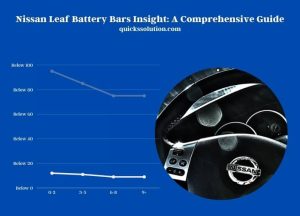Published on: November 16, 2023
Written by Amlan Roy / Fact-checked by Hashim Manna
Battery saver active is a notification indicating that your vehicle’s system has detected a drop in the battery’s charge and is conserving energy. This mode is designed to extend the battery’s life by limiting the power to non-essential systems.
When your car displays a “battery saver active” message, it may sometimes lead to the car not starting. This is often a sign that the battery is unable to hold enough charge to power the starter motor. Addressing this issue may involve charging or replacing the battery. If you’re wondering whether a new battery is needed when this message appears, it’s not always the case. The message can be triggered by various factors, including a weak alternator or electrical system issues.

Understanding what causes the battery saver mode to activate is crucial. In vehicles like the Chevy Cruze, Buick, or Chevy Volt, this feature is often activated due to a drop in the battery’s voltage, which could be due to an aging battery, faulty charging system, or power-draining accessories. If you’re driving in battery saver mode, the duration you can continue without issues varies. It largely depends on the battery’s condition and the electrical demands of your vehicle.
For those looking to fix the battery saver active issue, the first step is to check the battery and charging system. Sometimes, a simple battery recharge or alternator check can resolve the problem. If the issue persists, professional diagnostic tools can help identify the root cause.
For a more detailed understanding of the “battery saver active” message and its implications for your vehicle, you’re invited to read the detailed article below. This will provide further insights into maintaining your vehicle’s battery health and ensuring a smooth driving experience.
Unraveling the Meaning of Battery Saver Active in Vehicles
Understanding Battery Saver Active
Definition and Basic Function
The term ‘battery saver active’ might sound complex, but it’s actually a straightforward concept. This feature is a lifesaver for your car’s battery. When your vehicle senses that the battery’s charge is dropping below a certain level, it springs into action. The system starts limiting the power supply to non-essential components. This is like your car saying, “Let’s focus on the essentials to keep rolling!” It’s a smart move to prevent your battery from draining completely, ensuring you don’t end up stranded with a car that won’t start.
The Role of Vehicle’s Electrical System
Your car’s electrical system is like the nervous system of the human body – complex and vital. The battery, alternator, and other electrical components work in harmony to power everything from your headlights to the radio. When the battery saver mode is active, it’s a sign that this system is working overtime to manage the available power efficiently. It’s ensuring that critical functions like headlights and ignition systems get priority over less crucial ones like the entertainment system. This balance is key to keeping your car running smoothly, even when the battery is under stress.
Common Triggers for Battery Saver Activation
Top Reasons for Activation in Different Car Models
| Car Model | Common Triggers for Battery Saver Activation |
| Chevy Cruze | Alternator issues, extreme temperatures |
| Buick | Old battery, frequent short trips |
| Chevy Volt | Electrical system faults, battery aging |

Environmental and Usage Factors
The activation of the battery saver mode isn’t just about the car’s internal issues. External factors play a big role too. For instance, extreme temperatures, be it scorching summer heat or freezing winter cold, can stress your battery. Also, your driving habits matter. If you’re someone who takes many short trips, your battery doesn’t get enough time to fully recharge, leading to frequent activation of the battery saver mode. It’s like running a marathon with no breaks – eventually, your energy levels will drop.
Impact on Vehicle Performance
Short-Term Effects on Car Functionality
When your car enters battery saver mode, you might notice some immediate changes. The air conditioning might not be as cold, or the infotainment system might dim or shut off. These are not signs of a malfunction; rather, they’re your car’s way of rationing power to essential systems. Think of it as your vehicle being frugal with its energy use. While these changes can be inconvenient, they’re a small price to pay for keeping your car running.
Long-Term Risks for Vehicle Health
Ignoring the battery saver active signal can lead to more serious issues down the road. Continuous strain on the battery can shorten its life, leading to costly replacements. It’s like ignoring a minor health issue until it becomes a serious problem. Regularly running on low battery can also put extra strain on other components like the alternator, leading to a domino effect of automotive health issues.
Battery Saver Active and Car Start Issues
Correlation Between Battery Saver Mode and Starting Problems
One of the most common symptoms of a car in battery saver mode is difficulty starting. This happens because the system is conserving energy, and starting a car requires a significant amount of power. It’s akin to trying to start a marathon after you’ve already run a long distance. Your car’s battery, already conserving energy, might not have enough juice to turn the engine over.
Case Studies: Instances Where Cars Failed to Start
There have been numerous instances where cars failed to start due to the battery saver mode. For example, a Chevy Cruze owner reported that their car wouldn’t start after the “battery saver active” message displayed. It turned out to be a combination of a weak battery and a faulty alternator. These real-life examples highlight the importance of not ignoring this warning.
Troubleshooting Battery Saver Active Issues
Step-by-Step Guide to Diagnose the Problem
If you see the battery saver active message, don’t panic. Start by checking the battery’s charge level. If it’s low, try charging it. If the problem persists, check the alternator and electrical connections. Sometimes, the issue could be as simple as a loose wire or as complex as a failing alternator. It’s like being a detective, where you methodically eliminate suspects to find the culprit.
Troubleshooting Checklist
| Step | Action to Take |
| 1. Check Battery Charge | Use a voltmeter to check the battery level |
| 2. Inspect Battery Terminals | Look for corrosion or loose connections |
| 3. Test Alternator | Check if the alternator is charging properly |
| 4. Scan for Electrical Faults | Use a diagnostic tool to check for faults |

Maintaining Your Car’s Battery Health
Preventive Measures and Regular Maintenance Tips
Maintaining your car’s battery is key to preventing the battery saver mode from activating frequently. Regularly check your battery’s charge level, especially in extreme weather conditions. Keep the terminals clean and ensure the connections are tight. Also, try to take longer drives occasionally to allow the battery to fully recharge. It’s like taking care of your health to prevent illness.
Maintenance Schedule and Best Practices
| Maintenance Activity | Recommended Frequency |
| Battery Inspection | Every 6 months |
| Terminal Cleaning | Every 12 months |
| Battery Replacement | Every 3-5 years |

Professional Intervention and When It’s Needed
Signs That You Need to Consult a Mechanic
Sometimes, DIY solutions just won’t cut it. If you’ve tried troubleshooting and the problem persists, it’s time to see a professional. Warning signs include the battery saver mode activating frequently, dimming headlights, and electrical components malfunctioning. It’s like knowing when to see a doctor instead of self-medicating.
Cost Implications of Ignoring Battery Saver Warnings
Ignoring the battery saver active message can lead to more expensive repairs down the line. A failing battery can strain the alternator and electrical system, leading to a cascade of issues. It’s not just about the cost of a new battery; it’s about preventing a chain reaction of automotive problems that can hit your wallet hard.
In summary, the battery saver active message is your car’s way of telling you it’s conserving energy to keep going. Understanding this feature, its triggers, and how to maintain your battery can save you from unexpected breakdowns and costly repairs. Regular maintenance and timely professional intervention are key to keeping your vehicle in top shape. Remember, taking care of your car’s battery is not just about avoiding inconvenience; it’s about ensuring the longevity and health of your vehicle.




